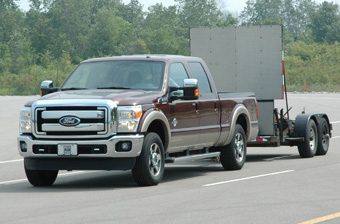
FLAT ROCK, MI – Numbers don’t lie, and our testing proved it.
But sometimes they don’t tell the whole story.
On paper, the GMC Sierra Heavy Duty pickup with its 6.6L, direct-injected V-8 Duramax turbodiesel is the clear-cut power champ among the Best Engines Diesel Shootout trio Ward’s pitted head-to-head.
Its 397-hp and 765-lb.-ft. (1,037-Nm) torque ratings easily outdistance the 350-hp/650-lb.-ft. (881-Nm) output of the Dodge Ram HD’s 6.7L inline-6 Cummins Inc. diesel.
They also narrowly top the 390-hp/735-lb.-ft. (997-Nm) peaks of the Ford Super Duty tested, although Ford since has announced it will step up the power rating of its new 6.7L V-8 diesel to 400 hp and 800 lb.-ft. (1,085 Nm) via a software tweak.
To find out whether the Sierra would deliver superior off-the-line acceleration, we took to the back-straight of the 1.3-mile (2.0 km) Robert Bosch LLC proving grounds here for a series of 0-60 mph (97 km/h) runs.

Two sets of tests were conducted, with and without trailers attached, using a speed gun and special computer software (courtesy of our colleagues at Motor Trend) to track the acceleration.
In the towing test, identical 10,000-lb. (4,536-kg) trailers were pulled with their foldable flaps in the up position. Measuring 6-ft. (1.8-m) wide and 4-ft.-8-ins. (1.4-m) tall, the flap simulates the type of speed-curbing wind resistance that could be expected when pulling a boxy camper 8-ft.-5-ins. (2.6-m) tall, pavement to roof.
In each case, the trucks carried four occupants, including the driver. Three runs were made per test, with only the best times used for comparison purposes.
Special Coverage
 Diesel Shootout
Diesel Shootout
And just as in the fine print, the Sierra came out on top.
With trailer in tow, the Sierra nosed out the Super Duty by 0.17 seconds to 30 mph (48 km/h) and held on by 0.13 seconds on the run up to 60 mph. The gap with the Ram was more pronounced at nearly a full second to 30 mph and by more than 4 seconds to 60 mph, as the Cummins engine ran out of breath.

Without trailers, the GMC and Ford trucks hit 60 mph in an impressive sub-10 seconds, almost sports coupe-like acceleration if this were still the 1980s. The Ram wasn’t bad either, at just over the 10-second mark.
But here’s the twist: The Sierra didn’t feel the strongest, either in our trailer-towing runs or in more general driving on and around the track here.
That honor goes to the Super Duty, which means sometimes perception can be more important than reality.
Credit the slight illusion to the Super Duty diesel’s baritone exhaust note, reined-in noise, vibration and harshness and exceedingly smooth interface with the truck’s all-new 6-speed automatic transmission.
| 0-30 mph/0-60 mph (without trailer) | 0-30 mph/0-60 mph (with trailer) |
|---|---|
| Ford: 3.66/9.41 | Ford: 6.35/20.40 |
| GM: 3.36/8.42 | GM: 6.18/20.27 |
| Ram: 3.66/10.15 | Ram: 7.16/23.99 |
Among the NVH-benefitting features are the engine’s compacted-graphite-iron block and inboard exhaust. In addition, resonators molded into the composite intake system are tuned to different sound-canceling frequencies. Two acoustic covers on the sides of the engine block mitigate high-frequency noise emitted by the injectors.
In contrast, the Sierra emits a high-pitched whine when pushed, creating the impression it is working much harder to produce very similar results. “It’s got the most torque, but it didn’t always feel that way,” notes one tester.
With the Super Duty’s new power boost, it stands to reason the Ford pickup now might have the edge over the Sierra when shot with the radar gun, as well.
But the upgrade’s effects on NVH are less clear. And as we’ve come to learn, it’s not solely about the numbers.
Composure counts. Sometimes it’s even the deciding factor.



